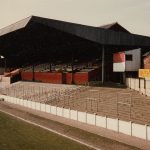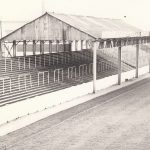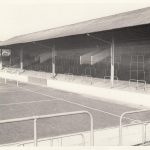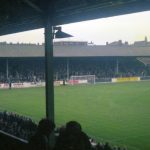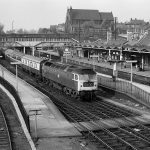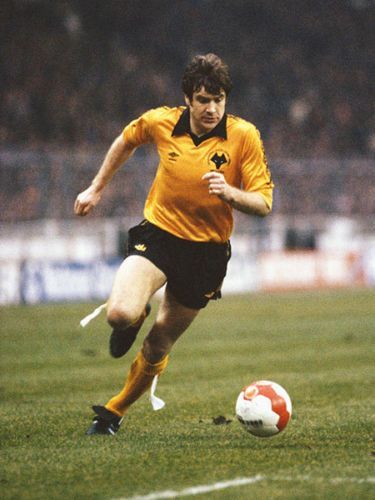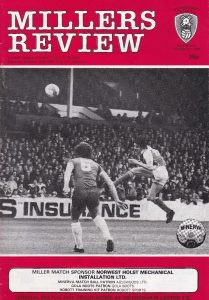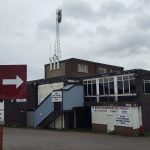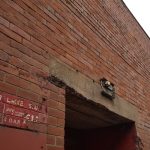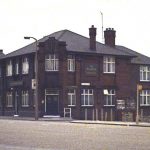
The clubs
Rotherham United were, as the name suggests, an amalgamation of two existing teams. When the Football League expanded following World War One, the town had two Midland League clubs – County, and Town. Rotherham County, who played at Millmoor, were accepted into the League. Rotherham Town weren’t, and struggled for support, so in 1925 Town and County merged to form United. (An earlier Rotherham Town, who played at Clifton Lane cricket ground, were League members between 1893 and 1896. The Clifton Lane ground still exists.)
Millmoor
A fan from those early days would have little trouble recognising 21st century Millmoor. The Main Stand dated from the Twenties: its roof was extended over the front paddock in the mid-Sixties, by the addition of an overhanging cover described by Simon Inglis as “like a bird’s beak”. Opposite, a barn-like terrace cover, also dating from the ground’s infancy, was later clumsily seated, and uncovered seats were bolted onto the adjacent terrace under a basic and functional cover in 1982. The Railway End terrace was roofed in 1957 and the home end on Masbrough Street in 1968. This much-loved kop was known colloquially as the Tivoli, in homage to the picture-house that stood on the opposite side of the road.
- main stand, 1960s
- terrace cover, 1970
- Railway End, 1970
- Tivoli
- 1980s: Tivoli on right (Aerofilms)
The area outside the ground aged less well. The Tivoli was demolished in 1989, after years of decay: the notorious Tivoli nightclub later occupied the site (for £15 entry you could drink free all night, as long as you kept hold of your glass. Punters flocked from as far away as Derby and Nottingham). Then there was Masbrough railway station. This was for many years the town’s principal station: situated in the cutting beneath Coronation Bridge, its entrance was opposite the home end, making Millmoor one of the very easiest grounds to get to by train. It was effectively decommissioned in 1987, when most trains diverted into the new Rotherham Central station.
- Tivoli
- ….decaying
- Masbrough station, 1970s
- ….decommissioned
In a rare modern development, construction of a new Main Stand began in 2004. This was to have held the corporate facilities regarded as essential in the modern game, along with a number of other fun accessories, but the doomed venture dragged on for some years without ever looking likely to be completed – at one point it was even delayed by the discovery of Japanese knotweed beneath the foundations. The sad, part-built structure, together with half-installed seats, became a symbol of the ground’s final seasons.
Millmoor’s strangest hour came in mid-1970, when Sportsnight featured a competition to find the best “kop choir”. The contest was sponsored by the Football League Review in an attempt to improve atmospheres and reduce bad behaviour at football grounds. It was hosted by David Coleman and judged by a studio panel of Bob Wilson, referee Roger Kirkpatrick and Football League secretary Alan Hardaker. The finalists were Liverpool, Tottenham, Southampton, Wolves, Newport and…. Rotherham. Singing a variety of songs including “The Mighty Quinn”, “Yellow Submarine” and “Ilkley Moor”, Rotherham fans surprisingly won the star prize – a three-day trip to the European Cup final and a Ford Cortina. “Newport County provided the dullest offering”, recalled one observer, “but made up for it by displaying the greatest number of fur-lined parkas.”
On the pitch, for those of us not old enough to remember 1955 when the Millers finished third in Division Two, it never got any better than the 1981-82 season. In June 1981 the club achieved something of a coup when they appointed Emlyn Hughes as player-manager. Hughes was fresh from a two-year stint at Wolves, during which he had captained the side to their 1980 League Cup win: he was best known, however, for his robust role in the stellar Liverpool side of the early Seventies. In 12 years, between 1967 and 1979, he won practically every honour in the game (that League Cup win completed the set). He represented England 62 times. He seemed just the sort of inspirational leader to take an ambitious club forwards.
Crazy Horse inherited a side that had just won the Divison Three title under Ian Porterfield. But they struggled in the higher league, and by the turn of 1982 occupied a perilous position towards the foot of the table. Then, in that intangible way a team’s fortunes can turn, something clicked. This was not altogether a surprise – Rotherham had some excellent, hard-working players, not least the lively striking partnership of Rod Fern and Ronnie Moore. But the scale of the revival caught every one by surprise. In the calendar month of February 1982, the Millers won eight games on the bounce, and completed the run – which remains a Football League record to this day – with a ninth in early March.
For the statistically-minded, those nine games were:
Tuesday 2nd February Derby County (h) 2-1
Saturday 6th February Cardiff City (a) 2-1
Tuesday 9th February Grimsby Town (a) 2-1
Saturday 13th February Cambridge United (h) 1-0
Tuesday 16th February Shrewsbury Town (h) 3-0
Saturday 20th February Bolton Wanderers (a) 1-0
Tuesday 23rd February Wrexham (h) 2-0
Saturday 27th February Crystal Palace (h) 2-0
Saturday 5 February Oldham Athletic (a) 3-0
- Fern
- Moore
For many people, however, the highpoints of that season came outside that narrow window, via two wins against a beleagured but still fashionable Chelsea – 4-1 at Stamford Bridge in March, and a still talked-about 6-0 at Millmoor. This latter, in October 1981, featured a virtuoso display by Fern and a catastrophic performance by visiting goalkeeper, Petar Borota. It marked the neurotic Serbian’s last appearance in a Chelsea shirt. Some sources report that a bottle of whisky was taken off him in the away dressing room, although it is not clear at what precise stage in the proceedings he turned to drink.
The whole glorious (for Millers fans) affair can be seen here: thanks to ThePieFace:
Millers 6 Chelsea 0 81/82
Yep – it happened – fact. And they were lucky to get nil. Sorry about the picture quality – but then it is 27 years old. If you blur your eyes you get used to it about a couple of minutes.
The 1981-82 season is generally regarded as a golden age for South Yorkshire football. Porterfield’s new team, the much-diminished Sheffield United, won Division Four at a canter. Barnsley, under the leadership of Norman Hunter – still biting legs five years after departing from Leeds – also boasted possibly their best side ever, with the talents of Mick McCarthy, Ronnie Glavin and Trevor Aylott spoken of to this day. Jack Charlton’s Sheffield Wednesday completed a trio of local teams pushing for promotion into the top flight. But in the event they all fell at the final hurdle. For their part Rotherham missed promotion by four points. Had they scored the two stoppage-time penaltes they missed in late-season games against Newcastle and Luton – the first of which ended their winning run – the record-breaking Millers side would have played in the First Division.
Landlord and tenant
No-one has ever been to Millmoor and not been aware of Booth’s scrapyard. For as long as anyone can remember the ground was gripped by it on three sides. Away fans accessed their unwelcoming turnstiles via a long, narrow and claustrophobic passage between its westerly spur and the high brick wall of the side terrace (in 2000 a Swansea fan died here, controversially trampled by a horse as police reacted to a crowd disturbance). Its cranes swooped over the Railway End as they went about the yard’s principal business of dismantling railway carriages and engines. In 1987 Inglis commented “Having seen what Booth’s machines can do to rolling stock, I wouldn’t give frail Millmoor much of a chance.” They were prescient words.
That very year, scrapyard owner Ken Booth bought the Millers out of administration. He was to be chairman for the next 17 years, eventually selling the club – by then significantly in debt – to a supporters’ group for a nominal fee. Significantly, though, he retained the freehold – and on terms increasingly viewed by the new owners as onerous. By 2008 the two parties were daggers drawn and United were negotiating with the Council to build a new “community stadium” on a site in the town centre. Unable to agree terms in the meantime, new chairman Tony Stewart took them away from Millmoor and into a short-term tenancy at Sheffield’s Don Valley Stadium, a white elephant legacy from the 1991 Student Games, until Millmoor’s modern replacement, the New York Stadium, was ready in 2012.
Millmoor today
Millmoor is unusual among “ghost” grounds because – well, it is still where it always was, and pretty much as the last fan left it. There seem to be no published plans regarding the future, but signs around the area promising “regeneration” suggest the old place’s days may be numbered.
- tracks
- trees
- tragic
- frontage
- floodlight
- foliage
- Tivoli
- turnstile
- tariff
- pipes
- passage
- pylon
- grafitti
- growth
- grim
For a time a local junior matches were played here, affording the groundhopping fraternity an opportunity to bag a quirky venue. But there is no doubt the Millers’ departure pulled down an area that was struggling to begin with. This is evident in the “pub test”. In much the same way that small businesses around Vetch Field declined overnight once the Swans moved out, the pubs and fast-food shops that once surrounded Millmoor are no more. The Millmoor Inn, dominating the corner of Millmoor Passage and in its day a true gauntlet for away fans to run, is now a shell: the bricked-up ground floor remains, but only to enclose the ever-encroaching scrapyard beyond.
- before
- after
The final word on this desolate place and what it once was goes to the observant Inglis. “Altogether”, he remarked, “Millmoor is quite a mix of oddities in odd surroundings, but as the result of good maintenance and lots of red paint, is actually a compact, cosy and cheerful island in the midst of a clanking and rather noisome sea of debris.”


